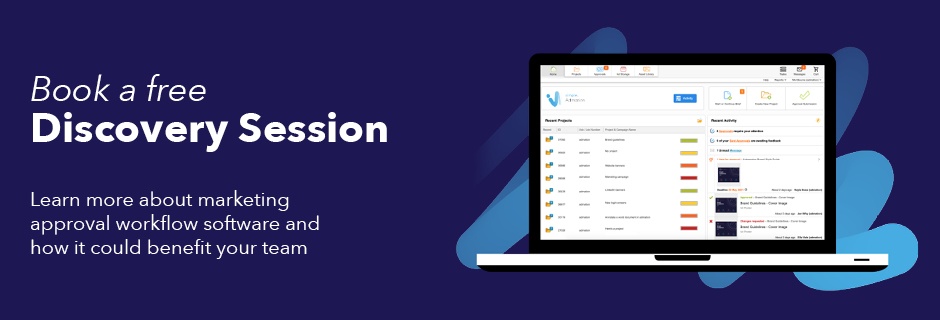
Why the New Year is the Best Time to Review Your Marketing Workflows
By Jodie Byass
For marketing operations professionals, the New Year is more than a fresh calendar—it’s a critical opportunity to step back, reflect, and make strategic adjustments to your marketing workflows, approval processes, and tools. This period is often a rare lull between major projects, providing the space to evaluate past performance, identify inefficiencies, and set the foundation for a more effective year ahead.
This article delves into why this time of year is uniquely suited for reflection and action, offering actionable insights to help senior marketers optimise their workflows, boost compliance, and streamline and optimise their marketing operations.
Understanding Marketing Workflows
Marketing workflows are a crucial component of any successful marketing team. They help streamline marketing activities, improve team satisfaction, efficiency, and quality, and enable teams to work more predictably and efficiently. By establishing clear steps and processes, marketing workflows ensure that every team member, internal and external stakeholder knows their role and responsibilities, reducing confusion and enhancing collaboration.
What is a Marketing Workflow?
A marketing workflow is a sequence of steps that a team takes to complete a marketing task. It is a tool used by marketing operations to create a consistent set of simple steps and processes for delivering a marketing campaign or project. A marketing workflow outlines the steps typically taken when beginning any similar campaign or project, helping teams save time and produce high-quality work by building consistency over time and reducing missed steps. By having a well-defined workflow, marketing teams can ensure that all necessary tasks are completed in a timely and efficient manner, leading to more successful campaigns and projects, better ROI and marketing resource utilisation.
Why the New Year is the Right Time for Reflection
-
A Natural Pause Between Projects For many organisations, the start of the year falls in a quieter phase, with larger campaigns typically ramping up later. This gap offers a chance to focus on strategic improvements without the pressure of immediate deadlines.
-
Data-Driven Insights from the Previous Year The New Year brings an opportunity to assess the previous year holistically. By analysing the success of campaigns, approvals, and team workflows, marketers can pinpoint exactly what worked well and where processes broke down. This approach fosters data-driven improvements that align with long-term business goals.
-
Team Alignment and Recalibration The reflective tone of the New Year also encourages collaborative discussions involving the entire team. Teams are often more open to change and innovation during this period, making it easier to propose and implement workflow adjustments. By involving the entire team, tasks can be assigned more effectively, ensuring everyone stays informed about project progress.
-
Resetting for Agility in a Dynamic Landscape Marketing operations thrive on agility, but agility demands regular course corrections. The New Year is the perfect time to ask: Are our tools and workflows helping us adapt to changing market demands, or are they holding us back?
The Importance of Marketing Operations for Marketing Teams
Marketing operations is a vital function in a business that enables other marketing departments to bring cohesion to campaigns and processes. Without marketing operations, it would be challenging for marketing teams to complete essential activities effectively. Marketing operations teams are responsible for managing the complexity of technology and ensuring it works as it should. They play a crucial role in supporting the systems and processes that enable the marketing team to perform optimally in their roles.
Why is Marketing Operations Important?
Marketing operations teams are responsible for managing the complexity of technology and ensuring it works as it should. They play a crucial role in supporting the systems and processes that enable the marketing team to perform optimally in their roles. According to a study, 93% of B2B marketers say the marketing operation’s function is important or critical to delivering digital transformation. This highlights the essential role that marketing operations play in ensuring that marketing teams can leverage technology effectively to achieve their goals.
Steps to Review and Enhance Your Marketing Workflow Management
1. Reflect on Past Workflows: Learn from Wins and Losses
-
Dive into Campaign Performance: Look beyond surface-level metrics. For instance, if a campaign exceeded its ROI targets, what role did the workflow play? If it fell short, was it due to delays in approvals, unclear briefs, or resource bottlenecks?
-
Identify Patterns: Assess how well your team collaborated on creative workflows. Did specific phases consistently cause delays or confusion? Recognising recurring challenges is the first step to solving them.
Insight: High-performing marketing operations professionals view workflow and process reviews not as routine tasks but as opportunities to strengthen team dynamics and operational resilience.
2. Evaluate Approval Processes: Eliminate the Friction
-
Pinpoint Bottlenecks: Where does the review and approval process stall? Are there layers of unnecessary bureaucracy, or do stakeholders struggle with unclear decision points? A well-structured review and approval process is crucial for reducing delays and enhancing communication. Implementing effective feedback mechanisms and structured workflows can streamline this process, ensuring clear communication between stakeholders and a better understanding of campaign goals.
-
Balance Compliance with Efficiency: Many teams sacrifice speed for compliance, but modern tools can achieve both. Implement structured approval workflows that incorporate checklists for legal and regulatory requirements without derailing timelines.
Perspective Shift: Senior marketing leaders should view approval processes as enablers of creativity, not barriers to progress. A well-optimised approval system reduces frustration and empowers teams to deliver their best work.
3. Audit Your Martech Stack: Build a Foundation for Scalability
-
Comprehensive Audit: Inventory all tools used across your marketing operations, categorising them by function—project management, creative workflows, analytics, and compliance.
-
Ensure that the project manager utilizes project management software to streamline team collaboration and align processes with project briefs, particularly in managing the workflow for marketing approval processes.
-
-
Measure ROI: Are your tools delivering measurable value? For instance, does your project management software streamline team collaboration, or does it add administrative overhead?
-
Eliminate Redundancy: If two tools have overlapping features, prioritise the one that integrates best into your workflows.
Thought Leadership Angle: Investing in fewer, more effective tools aligns with the rising trend of Martech consolidation, a strategy increasingly favoured by marketing managers and leaders to reduce complexity and costs.
4. Set Bold but Realistic Goals for Improvement
-
Define Success Metrics: Instead of generic goals like “improve efficiency,” set quantifiable objectives such as “reduce project turnaround time by 20%” or “streamline approvals to achieve a two-day average.”
-
Align with Business Strategy: Tie workflow improvements to broader organisational goals. For example, if the business priority is entering new markets, ensure your workflows are agile enough to handle rapid campaign localisation. Additionally, highlight how these improvements can enhance the efficiency and profitability of various marketing projects, emphasizing the importance of collaboration and transparency in managing these projects.
Pro Tip: Align your team around a shared vision for workflow improvements. Engage them early to build momentum and enthusiasm for change.
5. Pinpoint and Resolve Bottlenecks: Map Out the Details
-
Analyse Key Stages: Break down your marketing workflows into distinct phases, from briefing to execution. Identify where delays, miscommunications, or duplicated efforts occur.
-
Address Common Issues: Are briefs unclear? Are multiple revisions causing unnecessary delays? Use team feedback and data to guide targeted interventions. Involve key stakeholders in identifying and resolving these bottlenecks to ensure alignment and effective solutions.
Perspective: Bottlenecks often indicate a deeper misalignment between tools, processes, and team expectations. Fixing these at the source yields long-term benefits.
6. Embrace Technology for Creative Workflows and Compliance with Internal and External Stakeholders
-
Adopt Flexible Tools: Explore platforms that cater specifically to marketing workflows, such as Admation. Look for features like centralised project management, approval automation, and compliance tracking.
-
Test Before Committing: Schedule demos to ensure any new tools align seamlessly with your team’s processes and improve productivity.
Future Focus: With AI and automation reshaping marketing technology, the tools you choose today must be adaptable to tomorrow’s innovations.
The Advantages of Starting Fresh
Reassessing and optimising your marketing processes and workflows early in the year isn’t just a box-ticking exercise—it’s a strategic investment. By refining your workflows, approval processes, and tools, your team can unlock several competitive advantages:
-
Streamlined Operations: Efficient workflows minimise wasted time and resources, driving faster execution.
-
Enhanced Collaboration: Transparent processes and tools foster alignment across teams and stakeholders, keeping team members on the same page through effective communication and centralized feedback.
-
Stronger Compliance: Structured workflows reduce risk, ensuring your campaigns adhere to legal and brand standards.
-
Maximised Creativity: With less time spent on admin, teams can focus on delivering exceptional creative work.
-
Scalable Systems: A well-optimised Martech stack positions your team for long-term growth and adaptability.
How Admation Can Elevate Your Marketing Operations
Admation offers marketing operations professionals the tools they need to streamline workflows and approvals, ensuring compliance without sacrificing creativity:
-
Centralised Project Management: Simplify project briefing, task allocation, timelines, and communication within a centralised platform.
-
Approval Workflow : Tiered approvals, automated reminders, and real-time tracking eliminate delays.
-
Compliance Built-In: Approval checklists and audit trails ensure campaigns meet all necessary standards.
-
Resource Management: Allocate resources efficiently to optimise capacity and avoid overloading teams and maximise resource utilisation.
-
Collaboration-First Design: Shared project views and version control keep teams aligned and minimise confusion.
Make 2025 Your Most Productive Year Yet
The New Year is a rare opportunity to hit reset and refocus. For senior marketing operations professionals, this means revisiting the fundamentals of your marketing teams' workflows, approval processes, and Martech stack. With thoughtful reflection and the right tools, you can set your team up for a year of unparalleled creativity, compliance, and operational excellence.
If you’ve reviewed your processes and identified areas for improvement—or if you’d like expert assistance in assessing your current workflows—our team is here to help.
Ready to revolutionise your marketing operations? Book a Demo with Admation today to take the first step toward streamlining approvals, enhancing collaboration, and optimising your workflows for success in 2025. Let’s work together to unlock your team’s full potential.
{{cta('3c7db2a0-d59d-4bcc-9f59-96fd37ebf1ee','justifycenter')}}

